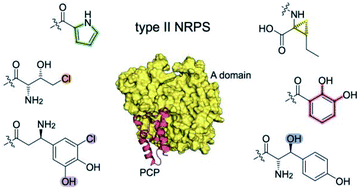Type II non-ribosomal peptide synthetase proteins: structure, mechanism, and protein–protein interactions
Abstract
Covering: 1990 to 2019
Many medicinally-relevant compounds are derived from non-ribosomal peptide synthetase (NRPS) products. Type I NRPSs are organized into large modular complexes, while type II NRPS systems contain standalone or minimal domains that often encompass specialized tailoring enzymes that produce bioactive metabolites. Protein–protein interactions and communication between the type II biosynthetic machinery and various downstream pathways are critical for efficient metabolite production. Importantly, the architecture of type II NRPS proteins makes them ideal targets for combinatorial biosynthesis and metabolic engineering. Future investigations exploring the molecular basis or protein–protein recognition in type II NRPS pathways will guide these engineering efforts. In this review, we consolidate the broad range of NRPS systems containing type II proteins and focus on structural investigations, enzymatic mechanisms, and protein–protein interactions important to unraveling pathways that produce unique metabolites, including dehydrogenated prolines, substituted benzoic acids, substituted amino acids, and cyclopropanes.



 Please wait while we load your content...
Please wait while we load your content...